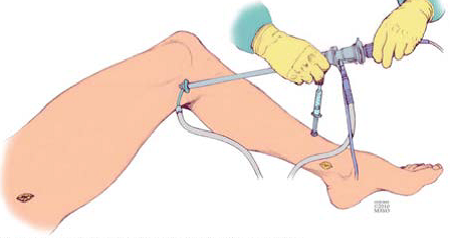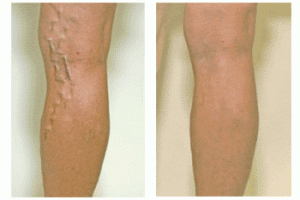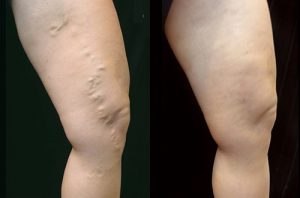Varicose Vein Surgery for the Treatment of Varicose Veins and Complications

Traditionally surgery was the only effective treatment for varicose veins, but the role of surgery in treating veins is definitely being re-evaluated in the light of the development of new treatments. Surgery still has a place in the modern treatment of varicose veins. By borrowing from some aspects of the newer techniques modern surgery has become less traumatic and minimally invasive. It is still often the best option for the largest varicose veins which will be completely removed. It is also effective for smaller varicose veins in favourable patterns. Surgery will not help thread or spider veins which are found within the most superficial layers of the skin itself and cannot be physically removed.
-Surgical treatments are described in detail in this article.
Varicose Vein Stripping
Varicose vein stripping is a surgical procedure that removes varicose veins from the legs or thighs. Varicose veins are the puffy and twisted veins that you can see under the skin. They usually have a red or bluish-purple color. Varicose veins most often appear in the legs, but they may also develop in other parts of the body. Your doctor may recommend varicose vein stripping if you’re experiencing:
- constant pain, throbbing, and tenderness in the legs
- skin sores and ulcers
- blood clots
- bleeding from the veins
Varicose vein stripping may also be done if you’re concerned about the cosmetic appearance of your legs. Speak with your doctor to see if varicose vein stripping is a good option for you.
Varicose vein stripping is often done on an outpatient basis, which means you’ll be able to go home the same day as the surgery. The procedure typically takes 60 to 90 minutes. During varicose vein stripping, your surgeon will make several small cuts, or incisions, near the top and bottom of your damaged vein. One incision will be in your groin. The other will be farther down your leg, either in your calf or ankle. They will then thread a thin, flexible plastic wire into the vein through the groin incision. The wire will be tied to the vein and pulled out through the cut in the lower leg. Your surgeon will then close the cuts with stitches and place bandages and compression stockings on your legs.
Recovery
It usually takes two to four weeks to recover from varicose vein stripping. However, your recovery time will depend on how many veins were stripped and where they were located.
Risk
Varicose vein stripping is a safe, low-risk surgical procedure. However, there are always risks associated with surgeries. These include:
- an allergic reaction to anesthesia
- infection at the incision sites
- heavy bleeding
- blood clots
- bruising or scarring
- nerve injury
Phlebectomy
Phlebectomy is a minimally invasive procedure that uses a small scalpel or needle to remove varicose veins on the surface of the leg. It’s highly successful when performed in patients who are good candidates.
Ambulatory Phlebectomy Procedure
Before the procedure, the patient’s leg is marked to identify the veins that need removal. Next, a local anesthetic fluid is injected into the areas surrounding the vein. Since vein surgery is typically performed under local anesthesia, patients do not feel any pain during the procedure. The physician will than make tiny incisions the size of a ballpoint pen tip (about 2-3 mm). A phlebectomy hook is inserted under the surface of the skin to remove the varicose vein through the tiny incision. This procedure is usually completed between 30 minutes and one hour.
Transilluminated Powered Phlebectomy
Transilluminated Powered Phlebectomy is similar to ambulatory phlebectomy but slightly more invasive. It is performed on an outpatient basis in an operating room under light anesthesia. After making two small incisions near the varicose vein, the surgeon inserts a canula illuminator that contains a fiber optic light that makes the veins easily visible. Fluid containing a local anesthetic is infused under the skin, loosening the vein from the surrounding tissue. A vein remover instrument is guided to the vein, which is suctioned into the instrument where it is cut into small pieces and removed. Thanks to the large amount of local anesthetic used, patients usually awake without any pain and are able to return home in about an hour. They can return to their normal activities immediately and to work within a few days.
Recovery
Minor bruising and swelling post procedure is normal and will subside after a few days. Additionally patients may notice bumps or lumps in the areas under the incisions, as well as experience burning, intermittent discomfort, numbness, or tingling in the incision area. These issues will typically resolve themselves after a couple of weeks. Patients are encouraged to walk immediately following surgery and carry on normal daily activities. For a minimum of 1 week following the procedure, patients will wear compression stockings daily. Vigorous exercise and heavy lifting should be avoided for at least 3 days following the procedure. The incisions heal completely without the need for sutures, and after 6 to 12 months, they are practically undetectable.
Risk
- Any procedure where the skin is penetrated carries a risk of infection. The chance of infection requiring antibiotic treatment appears to be less than one in 1,000.
- Skin pigmentation at the site of the treated varicose vein may occur but is usually temporary.
Endoscopic vein surgery
Endoscopic perforator vein surgery. This is a technical name for a procedure which is only performed in severe cases of varicose veins. This means cases where leg ulcers have developed as a result of damaged veins. Endoscopic vein surgery effectively treats varicose veins and ulcers.
Procedure

For endoscopic vein surgery, your doctor will make a small cut in your skin near a varicose vein. He or she then uses a tiny camera at the end of a thin tube to move through the vein. A surgical device at the end of the camera is used to close the vein. Endoscopic vein surgery usually is used only in severe cases when varicose veins are causing skin ulcers. After the procedure, you usually can return to your normal activities within a few weeks.
Recovery
There is no down time associated with this procedure and patients can often resume their daily activities after the procedure.
Risk
Varicose vein stripping is a safe, low-risk surgical procedure. However, there are always risks associated with surgeries. These include:
- an allergic reaction to anesthesia
- infection at the incision sites
- heavy bleeding
- blood clots
- bruising or scarring
- nerve injury
Phlebectomy
Phlebectomy is a minimally invasive procedure that uses a small scalpel or needle to remove varicose veins on the surface of the leg. It’s highly successful when performed in patients who are good candidates.
Ambulatory Phlebectomy Procedure

Before the procedure, the patient’s leg is marked to identify the veins that need removal. Next, a local anesthetic fluid is injected into the areas surrounding the vein. Since vein surgery is typically performed under local anesthesia, patients do not feel any pain during the procedure. The physician will than make tiny incisions the size of a ballpoint pen tip (about 2-3 mm). A phlebectomy hook is inserted under the surface of the skin to remove the varicose vein through the tiny incision. This procedure is usually completed between 30 minutes and one hour.
Transilluminated Powered Phlebectomy

Transilluminated Powered Phlebectomy is similar to ambulatory phlebectomy but slightly more invasive. It is performed on an outpatient basis in an operating room under light anesthesia. After making two small incisions near the varicose vein, the surgeon inserts a canula illuminator that contains a fiber optic light that makes the veins easily visible. Fluid containing a local anesthetic is infused under the skin, loosening the vein from the surrounding tissue. A vein remover instrument is guided to the vein, which is suctioned into the instrument where it is cut into small pieces and removed. Thanks to the large amount of local anesthetic used, patients usually awake without any pain and are able to return home in about an hour. They can return to their normal activities immediately and to work within a few days.
Recovery (h3)
Minor bruising and swelling post procedure is normal and will subside after a few days. Additionally patients may notice bumps or lumps in the areas under the incisions, as well as experience burning, intermittent discomfort, numbness, or tingling in the incision area. These issues will typically resolve themselves after a couple of weeks. Patients are encouraged to walk immediately following surgery and carry on normal daily activities. For a minimum of 1 week following the procedure, patients will wear compression stockings daily. Vigorous exercise and heavy lifting should be avoided for at least 3 days following the procedure. The incisions heal completely without the need for sutures, and after 6 to 12 months, they are practically undetectable.
Risk
- Any procedure where the skin is penetrated carries a risk of infection. The chance of infection requiring antibiotic treatment appears to be less than one in 1,000.
- Skin pigmentation at the site of the treated varicose vein may occur but is usually temporary.
Endoscopic vein surgery
Endoscopic perforator vein surgery. This is a technical name for a procedure which is only performed in severe cases of varicose veins. This means cases where leg ulcers have developed as a result of damaged veins. Endoscopic vein surgery effectively treats varicose veins and ulcers.
Procedure

For endoscopic vein surgery, your doctor will make a small cut in your skin near a varicose vein. He or she then uses a tiny camera at the end of a thin tube to move through the vein. A surgical device at the end of the camera is used to close the vein. Endoscopic vein surgery usually is used only in severe cases when varicose veins are causing skin ulcers. After the procedure, you usually can return to your normal activities within a few weeks.
Recovery
There is no down time associated with this procedure and patients can often resume their daily activities after the procedure.
Risk
This is generally a very safe procedure, causing relatively little pain and, in most cases, is well-tolerated. However, as with any surgical procedure, there are risks, including bleeding, infection, injury to the nerves and arteries that are adjacent to the veins, and recurrence of symptoms despite adequate ligation of the perforator vein.








